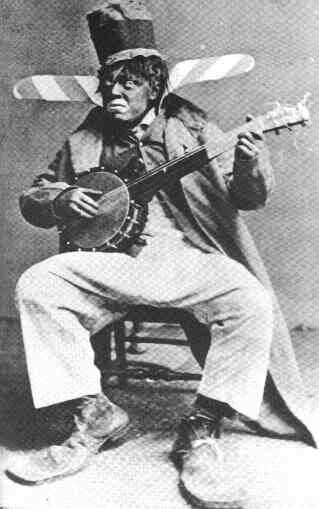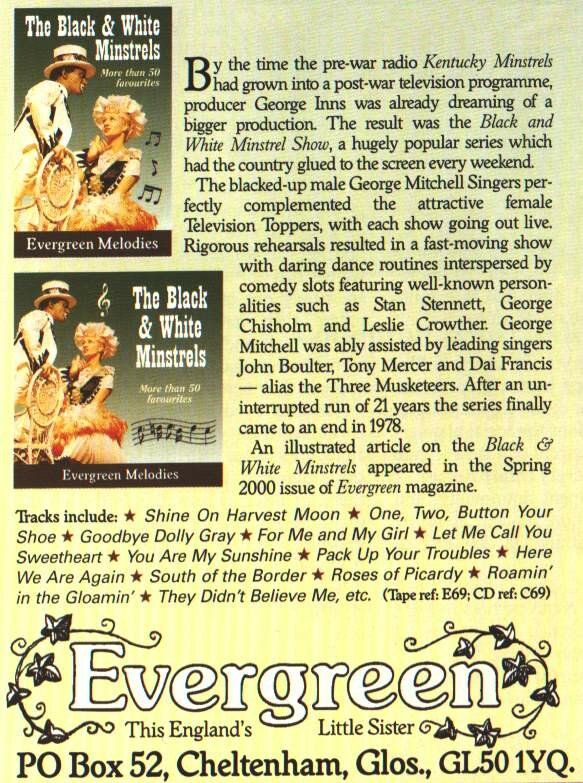|

1958 - 1978
One hundred years after the "Nigger Minstrel" entertainment tradition had begun in London's music-halls, the convention was revived on television in the form of The Black And White Minstrel Show. This variety series was first screened on BBC Television on 14 June 1958 and it was to stay on air for over the next two decades. The Black And White Minstrel Show evolved from the "Swannee River" type minstrel radio shows. One year before it was first broadcast on television, George Inns produced the 1957 Television Minstrels (BBC TV 2 September 1957) as part of the National Radio Show in London. See here.
The show featured the Mitchell Minstrels (with solo performers Dai Francis, Tony Mercer and John Boulter), conducted by George Mitchell and the Television Toppers dance troupe. Lightweight moments were provided by Leslie Crowther, George Chisholm and Stan Stennett during the early years.
|
| Minstrel History |
|

"Black Face", 1884: a lone Minstrel entertaining on Eastbourne Sands
|
Minstrel theatrical entertainment originated and developed in the U.S. in the first half of the 19th century, and consisting of songs, dances, and comic repartee typically performed by white actors made up as blacks. The minstrel show probably evolved from two types of entertainment popular in America before 1830: the impersonation of blacks given by white actors between acts of plays or during circuses; and the performances of black musicians who sang, with banjo accompaniment, in city streets. The "father of American minstrelsy" was Thomas Dartmouth "Daddy" Rice (180860), who between 1828 and 1831 developed a song-and-dance routine in which he impersonated an old, crippled black slave, dubbed Jim Crow. This routine achieved immediate popularity, and Rice performed it with great success in the U.S. and Great Britain, where he introduced it in 1836. Throughout the 1830s, up to the founding of the minstrel show proper, Rice had many imitators. |
|
In 1842, in New York City, the songwriter Daniel Decatur Emmett and three companions devised a program of singing and dancing in blackface to the accompaniment of bone castanets, fiddle (violin), banjo, and tambourine. Calling themselves the Virginia Minstrels, they made their first public appearance in February 1843 in a New York City theater. Another group called the Christy Minstrels, headed by the actor Edwin P. Christy (181562), began appearing a few years later and originated many essential features of the minstrel show, including the seating of the entertainers in a semicircle on the stage, with a tambourine player (Mr. Tambo) at one end and a performer on the bone castanets (Mr. Bones) at the other; the singing of songs with harmonized choruses; the exchange of jokes between the endmen and the performer in the center seat (Mr. Interlocutor); and the introduction of special variety acts at the conclusion of the bill.
In the 1850s the typical minstrel show had two parts. The first part included the comic exchange; songs by Tambo and Bones; sentimental ballads by such composers as the American Stephen Foster; a final song by the whole company; and a walk-around, a section in which, one at a time, each performer walked around the inside of the semicircle several times and finished by doing his particular specialty in the center of the stage. The second part, called the olio, consisted of specialty acts, clog dances, jigs, female impersonations, and a burlesque of some serious drama currently popular. Eventually the walk-around became a large ensemble finale that followed the olio.
After the American Civil War black entertainersoften also in blackface makeupbecame more prominent than before. The most famous of the black minstrelsy composers was James Bland (18541911). The minstrel show was the leading vehicle for popular music in the U.S. in the 19th century. Its banjo music influenced the development of ragtime, and its clog dancing, the evolution of tap dance. From 1850 to 1870 minstrelsy was at its height, and in the 1850s ten theaters in New York City alone were devoted almost solely to such entertainment. After 1870 the popularity of the minstrel show declined rapidly, and in 1919 only three troupes remained in the U.S. Economic reasons contributed to the decline, as did a growing craze for gigantic minstrel showsexemplified by Haverlys Mastodon Minstrels, with over 100 performers and lavish stage settings; and the famous Lew Dockstaders Minstrels, which presented elaborate programs related to modern vaudeville rather than to the older, simpler form.
|
|

Order form appears here (read blow for more information)
I have no personal interest in selling the tapes and cassette, but I'm getting a lot of emails about it. Here is some more information:
"This England" and "Evergreen" are two different magazines produced by the same company with the same mailing adddress. "This England" has not included the prices in their order form - it's an old fashioned company that hasn't quite got to grasp with the internet yet. It might be better to 'phone or order by mail.
The UK price for CD is £8.95 including UK postage. With airmail, the overseas price is as follows: US $18, Can $28, Aus $34, NZ $42.
Cassette tapes are cheaper. £7.50 including UK postage. With airmail, the overseas price is as follows: US $15, Can $24, Aus $30, NZ $37.
The address for This England is PO Box 52, Cheltenham, Gloucestershire, GL50 1YQ. Telephone Orders . Email
I am receiving a lot of emails requesting Black & White Minstrel video tapes (VHS). To date, I haven't found a source, but I will post here if I make a discovery.
|
Forward to Memorable Images 30
Back to Memorable Images 28
|

